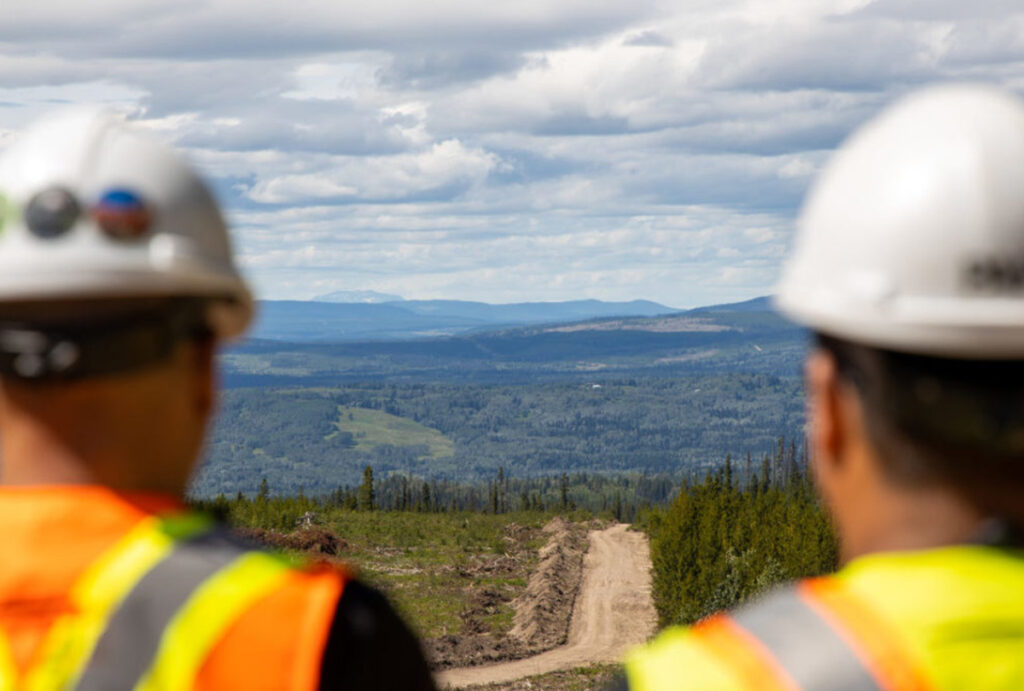Phasing out Canada’s responsible energy supply would not reduce global emissions
Follow CEC on Linkedin CEC Linkedin
Follow CEC on Facebook CEC Facebook
Follow CEC on Twitter CEC Twitter

Photo courtesy Coastal GasLink
The Canada Energy Regulator’s new scenarios for the future of Canadian energy show significant reductions in oil and gas production as the country works to reach net zero emissions by 2050.
But Canada doesn’t have to reduce oil and gas production to achieve net zero. And as global energy demand continues rising, phasing out responsibly produced supply from Canada would hurt the world.
Climate change is a global problem. Canada’s efforts to reduce emissions – particularly in the energy industry – must be in the context of what is happening around the world, which the CER does not model in detail.
Here are the facts.
Fact: The CER scenario does not reflect reality
The CER’s “global net zero” scenario, similar to the International Energy Agency (IEA)’s net zero scenario, is one way of looking at how the future could unfold. But it doesn’t reflect the trajectory the world is actually on.
For example, if the world was following the IEA’s net zero course, global oil demand would be declining now, on its way to 75 million barrels per day by 2030. In reality, it is set to hit a new record high of 102 million barrels per day this year and reach 106 million barrels per day in 2028, according to the IEA’s latest short-term outlook.
Russia’s invasion of Ukraine, with painful price spikes and the world’s highest-ever consumption of coal last year has underscored the world’s energy challenge. Renewables alone are not enough to provide the reliable, affordable energy we need. The world will need oil and gas long into the future.
If Canada intentionally phases out its supply, the world’s demand will still be met – not by Canada, benefitting Canadians, but by jurisdictions like Saudi Arabia and Russia, which don’t share our commitment to environmental protection or social progress.
It’s important to note that Canada does not have to introduce specific legislation to reduce oil and gas production for that result to come about. Policy could just as easily shrink production via indirect means, the Public Policy Form (PPF) noted earlier this year.
This includes “limiting pipeline or other infrastructure approvals and permits, constraining or discouraging investment, or setting an emissions cap level so stringent it is only achievable through production cuts,” PPF said.
Directly or indirectly, this “would deny existing producers the opportunity to innovate their way to a net-zero future.”
Fact: Canada does not have to single out oil and gas to reach net zero
It is not necessary for Canada to intentionally phase out oil and gas production to achieve net zero emissions, according to analysis by Navius Research for the PPF. Such a phase out “introduces economic pain with no added environmental gain.”
Reducing emissions is not the same as eliminating oil and gas, PPF noted. Navius Research found that phasing out Canadian oil and gas, rather than investing in non-emitting sources while reducing emissions from oil and gas, would cost Canada’s economy $100 billion by 2050 – the equivalent of a deep recession with no recovery ever materializing.
Phasing out Canada’s oil and gas production would reduce the incomes of everyday Canadians, and damage Canada’s exports by crippling its largest trade offering, PPF said. Most importantly, Canada can achieve net zero emissions more cost effectively by not singling out the oil and gas sector.
Overall, the CER does not model the economic impacts of its pathways to net zero. This is critical information that should be made public to Canadians.
Fact: Canadian natural gas can reduce global emissions
Climate change is a global issue, so solutions should be global in nature.
For example, switching from coal to natural gas to generate power reduces emissions by 50 per cent on average, according to the IEA. Supply from Canada – exported globally as liquefied natural gas (LNG) can do even better, reducing emissions by about 65 per cent compared to coal, according to Energy for a Secure Future.
Analysts expect world LNG demand to double over the next two decades as growing Asian economies look to get off high-emitting coal. LNG is now also seen a core energy supply source for Europe following Russia’s invasion of Ukraine.
Thanks to a colder climate, lower methane emissions from natural gas production, and the use of hydroelectricity, Canada’s LNG will have some of the lowest emissions in the world.
A 2022 study by Wood Mackenzie found that Canadian LNG exports could reduce net emissions in Asia by 188 million tonnes per year through 2050. That’s the annual equivalent of removing nearly three times B.C.’s total emissions, or getting rid of all internal combustion engine cars from Canadian roads.
If Canada shuts down its ability to supply the world with LNG, it will not change demand. The demand will just be met by other countries like the United States, Qatar and Australia.
Fact: Canadian oil and gas projects benefit Indigenous communities
Indigenous businesses and communities are becoming increasingly important players in Canadian oil and gas, and that’s good for Canada and the world.
“When Europeans, Asians and Americans think of Canada’s Indigenous peoples, they often think we oppose all energy development. We aren’t victims of development. Increasingly we are partners and even owners in major projects,” Haisla Nation Chief Councillor Crystal Smith said during a press conference in April.
The Haisla Nation is 50 per cent owner of the proposed Cedar LNG project, which would be the first Indigenous-owned LNG terminal in the world. The Haisla Nation views it as an opportunity to take ownership of industrial development on their lands and to use revenues to support local social, educational and health programs.
It’s just one example of the growing role of Indigenous communities in Canadian energy.
Indigenous communities will have a stake in the LNG Canada project development as well, with 16 communities to acquire a 10% stake in the Coastal GasLink pipeline once complete in 2023.
In Alberta, 23 First Nation and Métis communities are now approximately 12 per cent owners of seven operating Enbridge oil sands pipelines, the largest Indigenous energy transaction ever in North America.
Since 2014, Indigenous employment in Canada’s oil and gas sector has increased by more than 20 per cent, reaching an estimated 10,400 jobs in 2020, according to the federal government.
Together, three projects – the Trans Mountain Expansion, Coastal GasLink, and LNG Canada – have spent approximately $9 billion with Indigenous-owned and local businesses.
Phasing out Canada’s oil and gas industry would remove these opportunities from Indigenous communities.
Fact: Canada’s oil sands industry has a credible path to net zero
Six companies representing 95 per cent of Canada’s oil sands production have jointly committed to reaching net zero emissions by 2050. This is important as most of Canada’s oil production comes from the oil sands sector.
The anchor project of the group’s target to reduce emissions by 22 million tonnes by 2030 on the way to net zero by 2050 is carbon capture and storage (CCS) technology.
According to international bodies including the IEA and the United Nations Intergovernmental Panel on Climate Change, dramatic expansion of CCS operations around the world is vital to achieve climate targets. Both of CER’s new net zero scenarios recognize the key role CCS will play in reducing emissions.
Canada is already a leader in the technology, with five of the world’s 30 commercial CCS facilities. This accounts for about 15 per cent of global CCS capacity even though Canada generates less than two per cent of global CO2 emissions.
Canada’s CCS operations are working. Since 2000, CCS projects in Saskatchewan and Alberta have removed more than 47 million tonnes of emissions, or the equivalent of taking more than 10 million cars off the road.
Emissions in Canada’s “conventional” (non-oil sands) oil sector are already going down. According to Environment and Climate Change Canada’s latest report to the United Nations, emissions from conventional oil production were 26 megatonnes in 2021, down from 34 megatonnes in 2019.
The world will need oil for decades to come. Supply from Canada, where producers are committed to emissions reduction, is better for the planet than supply from other countries that do not share the same commitment to innovation.
Fact: Oil and gas benefits all Canadians
The Government of Canada acknowledges that oil and gas is a major contributor to Canada’s economy.
Ottawa reports that oil and gas supported nearly 600,000 jobs across Canada in 2020. This includes 178,500 “direct” jobs with oil and gas companies and 415,000 “indirect” jobs in supporting industries like engineering and manufacturing.
In addition to the concentration of jobs in oil and gas producing provinces, there are thousands of jobs in manufacturing, environmental, and financial services tied to the oil and gas industry, especially in Ontario and Quebec.
In 2020, the oil and gas industry generated $118 billion in GDP. Canada’s total GDP in 2020 was $1.65 trillion, indicating that the oil and gas sector accounted for about 7.2 per cent of the country’s economic activity.
At the same time, Canada exported $86 billion worth of oil and gas in 2020, or 16 per cent of the country’s total. Of those exports, 95 per cent went to the U.S.
These economic benefits would evaporate without Canadian oil and gas production.
Fact: Oil and gas still needed in IEA net zero scenario
Even in the IEA’s highly unlikely net zero scenario, in 2050 nearly 20 per cent of world energy needs are still supplied by oil and gas.
This includes non-combustion uses like petrochemical feedstock and asphalt, which crude from Canada’s oil sands is particularly well suited to supply. Researchers with Queen’s University recently found that asphalt from Alberta’s oil sands can extend pavement lifespan by 30 to 50 per cent.
The world needs more Canadian oil and gas, not less.
The unaltered reproduction of this content is free of charge with attribution to Canadian Energy Centre Ltd.
Share This:






